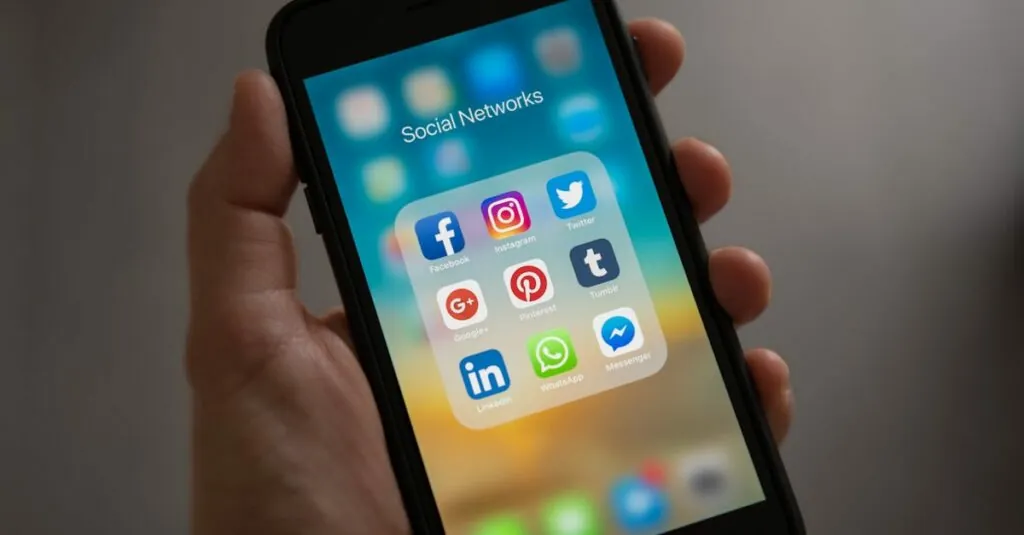Table of Contents
ToggleEver tried to watch a video on your iPhone only to find the screen stubbornly stuck in portrait mode? It’s like your phone has decided it prefers a narrow view of the world. Frustrating, right? You’re not alone in this battle against the uncooperative screen rotation.
Common Reasons For Screen Rotation Issues
Screen rotation problems on an iPhone often stem from a few common sources. Understanding these reasons helps in diagnosing and fixing the issue effectively.
Locked Orientation
Locked orientation prevents the screen from rotating. Users can check this setting by swiping down from the top-right corner to reveal the Control Center. An icon resembling a lock with an arrow around it indicates that rotation is locked. Simply tapping this icon unlocks the orientation. In many cases, users overlook this setting, which leads to frustration during video playback or gaming.
Software Glitches
Software glitches can disrupt screen rotation functionality. Restarting the iPhone often resolves temporary issues caused by background applications. Additionally, ensuring the device is updated to the latest iOS version addresses bugs that might impact rotation behavior. Users experiencing persistent problems may consider resetting all settings, which often rectifies software-related dilemmas while preserving personal data.
Troubleshooting Steps
To fix screen rotation issues on an iPhone, follow these targeted troubleshooting steps. Each method addresses specific problems effectively.
Restarting Your iPhone
Restarting an iPhone often resolves many minor issues. To do this, press and hold the side button along with the volume button until the slider appears. Swiping the slider turns off the device completely. After waiting for about 30 seconds, press the side button again to turn it back on. This action refreshes the operating system and can restore screen rotation functionality.
Checking Display Settings
Display settings might be the root of the problem. First, swipe down to open the Control Center. Here, check if the orientation lock icon is enabled. If the lock is on, tap it to disable rotation locking. Next, navigate to Settings then Display & Brightness. Make sure True Tone and night shift features are not conflicting with rotation. Adjusting these settings might help restore the desired screen orientation.
Updating iOS
Keeping iOS updated is vital for optimal performance. Go to Settings, then General, and tap on Software Update. If a new version is available, download and install it. Updates often include bug fixes that resolve issues like screen rotation problems. Regular updates ensure that the device operates smoothly and minimizes software-related headaches.
Advanced Solutions
For users still facing screen rotation issues after basic troubleshooting, advanced solutions may provide the necessary fix.
Resetting All Settings
Resetting all settings can resolve deeper system conflicts. This process returns settings to their default without deleting personal data. Begin by navigating to Settings, select General, and then tap Transfer or Reset iPhone. Choose Reset, followed by Reset All Settings. After this, the device may need to restart, so ensure all preferences, such as Wi-Fi passwords and wallpaper settings, will require reconfiguring. Completing this step often eliminates software-related malfunctions impacting screen rotation.
Checking for Hardware Issues
Hardware issues might also contribute to screen rotation problems. Users should inspect the physical state of the device, focusing on the accelerometer and gyroscope, which govern screen orientation. Dropping the iPhone can lead to internal damage that affects rotation capabilities. To assess this, a force restart may help, which involves quickly pressing and releasing the volume up button, then the volume down button, followed by holding the side button until the Apple logo appears. Should problems persist, visiting an Apple Store for diagnostics is advisable to rule out hardware failures.
When To Seek Professional Help
Persistent screen rotation issues may indicate deeper problems. If troubleshooting steps fail to resolve the problem, seeking professional assistance becomes necessary. Signs of hardware malfunctions, such as a malfunctioning accelerometer or gyroscope, often require expert intervention.
In cases where the iPhone continues to experience orientation issues even after a device reset, visiting an Apple Store can provide solutions. Apple’s technicians can perform diagnostics that identify underlying hardware failures. Moreover, customers should consider scheduling an appointment for more specialized attention.
User experience also plays a role; if frustration grows despite trying various fixes, professional help can save time and effort. Technicians utilize advanced tools to pinpoint problems beyond user capabilities. Therefore, engaging with a professional service not only ensures accuracy but also secures the device’s longevity.
Hardware repairs often include battery replacements or component fixes, which designated technicians can handle more efficiently. Knowledgeable staff guarantee that issues are diagnosed correctly, allowing for targeted repairs.
Engaging with Apple support via phone or online chat may provide immediate insight into the issue. A step taken early may prevent further complications. Heeding these indications can facilitate a smoother resolution to persistent screen rotation problems.
Screen rotation issues on an iPhone can be frustrating but they’re often manageable with the right approach. By following the troubleshooting steps outlined in the article users can quickly identify and resolve common problems. Whether it’s checking for orientation lock or updating iOS these solutions can restore the device’s functionality.
For those still struggling after basic fixes seeking professional help is a wise choice. Technicians can diagnose potential hardware failures ensuring users get the most out of their devices. Staying informed about both software and hardware aspects will enhance the overall user experience and prevent future disruptions.







